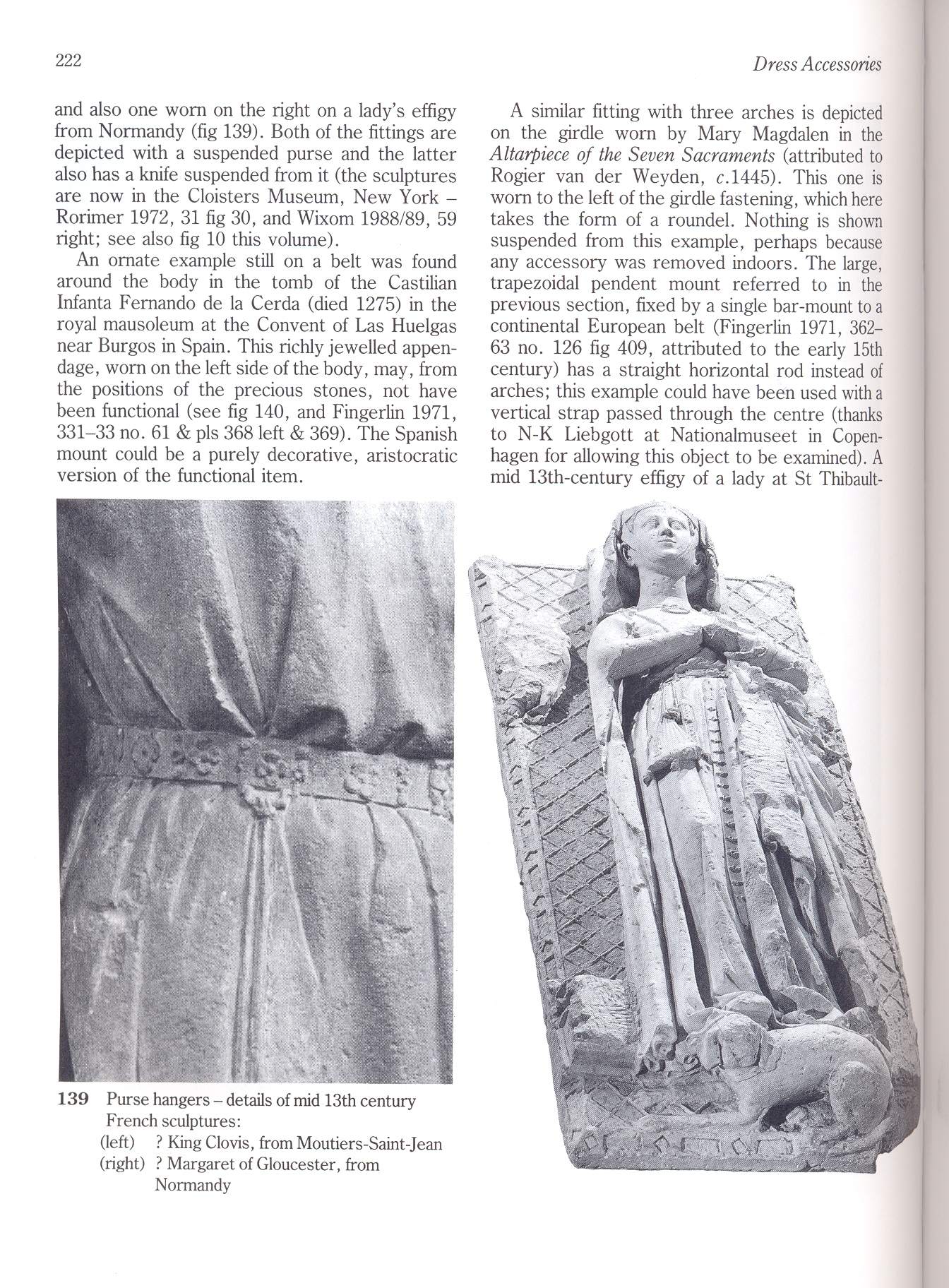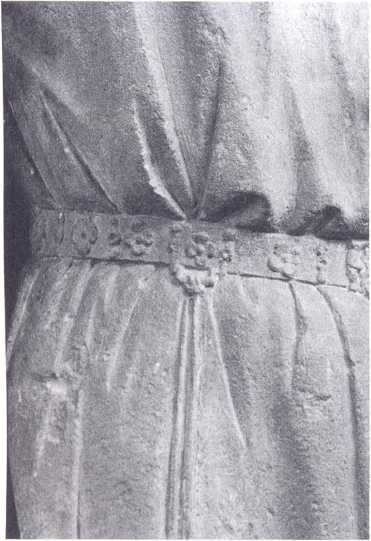251 (40)

222
Dress Accessories
and also one wom on the right on a lady’s effigy from Normandy (fig 139). Both of the fittings are depicted with a suspended purse and the latter also has a knife suspended from it (the sculptures are now in the Cloisters Museum, New York -Rorimer 1972, 31 fig 30, and Wixom 1988/89, 59 right; see also fig 10 this volume).
An omate example still on a belt was found around the body in the tomb of the Castilian Infanta Fernando de la Cerda (died 1275) in the royal mausoleum at the Convent of Las Huelgas near Burgos in Spain. This richly jewelled appen-dage, wom on the left side of the body, may, from the positions of the precious Stones, not have been functional (see fig 140, and Fingerlin 1971, 331-33 no. 61 & pis 368 left & 369). The Spanish mount could be a purely decorative, aristocratic version of the functional item.
A similar fitting with three arches is depicted on the girdle wom by Mary Magdalen in the Altarpiece of the Seven Sacraments (attributed to Rogier van der Weyden, c.1445). This one is wom to the left of the girdle fastening, which here takes the form of a roundel. Nothing is shown suspended from this example, perhaps because any accessory was removed indoors. The large, trapezoidal pendent mount referred to in the previous section, fixed by a single bar-mount to a Continental European belt (Fingerlin 1971, 362— 63 no. 126 fig 409, attributed to the early 15th century) has a straight horizontal rod instead of arches; this example could have been used with a vertical strap passed through the centre (thanks to N-K Liebgott at Nationalmuseet in Copen-hagen for allowing this object to be examined). A mid 13th-century effigy of a lady at St Thibault-

139 Purse hangers - details of mid 13th century French sculptures:
(left) ? King Clovis, from Moutiers-Saint-Jean (right) ? Margaret of Gloucester, from Normandy

Wyszukiwarka
Podobne podstrony:
276 (40) 248 Dress Accessońes because no indication has been recognized on them of the wearer’s adhe
278 (40) 250 Dress Accessories 1314 1311 SWA81 2186 (2055) 9 fig 160 Corroded
375 (18) 348 Dress Accessońes ribbon was then hemmed to the back of the pouch and the other oversewn
322 (32) 294 Dress Accessories Unthrown silk was bound round the wire in at least 11 examples (nos.
314 (34) 286 Dress Accessońes one side ending in chapes, wom by a woman. Pourpoints and aketons (bot
ACCESSORIES AND SPECIAL FEATURES 37CP 124-0083-426 Radomes. One per bay
LPC SERIES (MEDIUM POWER) ACCESSORIES AND SPECIAL FEATURES NTN NPN Radomes. One per bay
LPC SERIES (LOW POWER) ACCESSORIES AND SPECIAL FEATURES NTN NPN Radomes. One per bay
286 (34) 258 Dress Accessońes 166 Pentagonal, hexagonal and six-lobed brooches -odginał shapes resto
306 (35) 180 180 278 Dress Accessońes Cloth buttons and corresponding holes on a sleeve from a depos
318 (36) 290 Dress Accessories one has a tiny spoon at the opposite end from the nib, though MoL acc
333 (43) 306 Dress Accessories colours represented (nos. 1493, 1498, 1514 and 1524), were analysed b
427 (11) 400 Dress AccessoriesAcknowledgements In a work of tliis size and comp!exity the principal
431 (10) 404 Dress Accessońes —, 1987 ‘Report on the Composition of the Ingots and Axle-Cap’, in Mea
Summary Extraction of mandibular third molar is one of the most common and also the most difficult p
357 (21) 330 Dress Accessońes plain hoop, and set with a blue glass cabochon was excavated at Lyvede
367 (17) 340 Dress AccessoriesTin rumbler bells with four petal-like tabs cast in one with loop: A m
369 (15) 342 Dress AccessońesPurses (Identification of leather by Glynis Edwards, AMD Purses and pou
377 (19) 350 Dress Accessońes 1700 BC72 2822 (150) 11 fig 231 Pouch madę from a rectangular strip of
więcej podobnych podstron